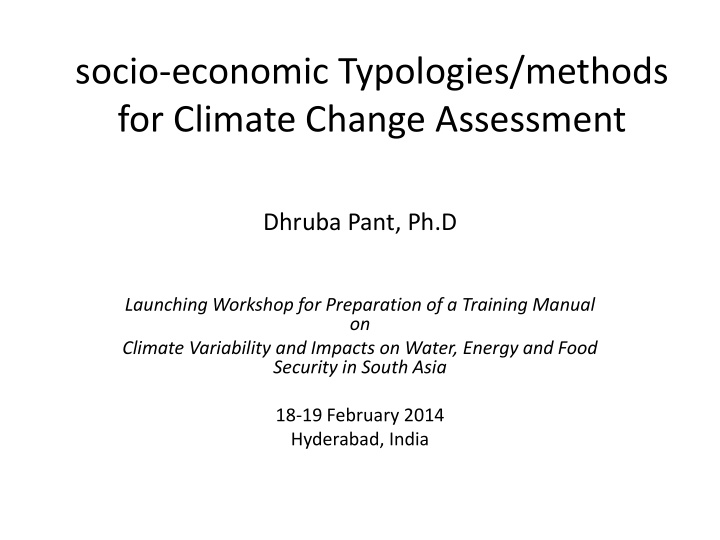



socio-economic Typologies/methods for Climate Change Assessment Dhruba Pant, Ph.D Launching Workshop for Preparation of a Training Manual on Climate Variability and Impacts on Water, Energy and Food Security in South Asia 18-19 February 2014 Hyderabad, India
Natural endowment parameters and Methods Resource mapping :Identify spatial distribution/location of roads, forests, water resources, farmlands, etc.
Social parameters and Methods Stakeholder analysis: identify types of stakeholders and stakes in NRM (CBOs,I/ NGOs, developmental agencies, etc.); Identify key social actors and their relationships between village and local people.
Social parameters and Methods Social mapping: map social institutions and organisations (such as schools, post office, telecommunication, police post) Identifying ethnic and caste groups clusters (main settlements).
Social parameters and Methods Wealth ranking: list out local people’s criteria of wealth and well-being; Identifying relative wealth and different socio-economic characteristics (categories/classes) of households. List problems and prioritize problems experienced by them.
Capital Assets Methods Human Resource Capacity status in the communities: list of skills and knowledge (literacy levels and workability by gender); Mobility mapping: social and gender equities/inequities in terms of contact with the outside world (markets, etc.). Number of people in foreign employment
Capital Assets Methods Physical Infrastructures mapping social institutions and organisations (access to infrastructure such as transport, water supply, irrigation, etc.) Trend line: developmental infrastructures (bridges, drinking water, roads, etc.)
Capital Assets Methods Financial Average income levels of different livelihood groups, consumption loan and borrowed by sample households; remittances Market structures present in the study area: labour market, nature of migration, wage rate received in different types of work
Livelihoods opportunities and strategies Method a. Productivity from existing activities • Agricultural productivity, small businesses, ability to save, access and opportunity to capital-credit; b. Health and food security • Child and infant mortality (probably from secondary sources), morbidity from diseases, environmental conditions, nutrition and balanced diets
C. Vulnerability and Resilience • Occurrence and vulnerability to natural disasters (landslides, floods, environmental degradation, deforestation, loss of ecosystem integrity, social, political and market disruption)
Institutional Environment • External institutional environment: local governance (local level empowerment, public awareness, political environment, development priorities and implementation priority, modality and types and status of development programs, governance structures, etc.) • Coping strategies of households: numbers of alternative livelihoods adopted by households
Participatory Action Plan • Process and contents of the Action Plan can be developed based on the following analyses: – List of major problems and solutions identified from analysis of both primary and secondary information. – Understanding opportunities, alternatives and options for improved livelihoods and infrastructures development.
Thank You
Recommend
More recommend